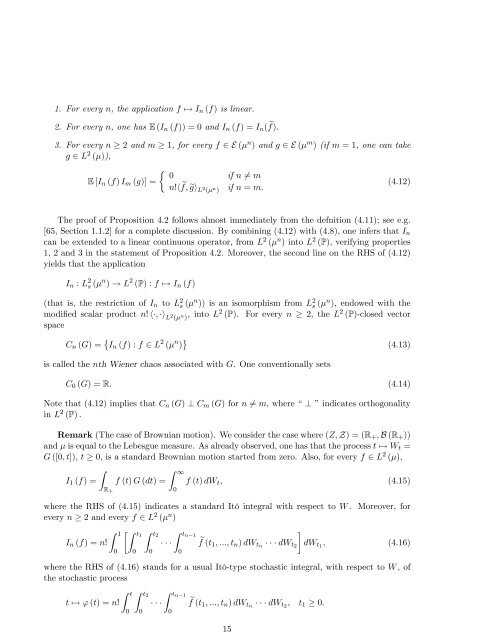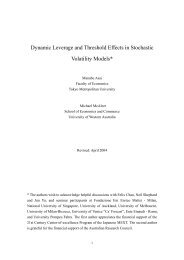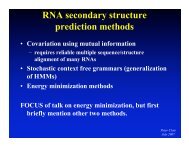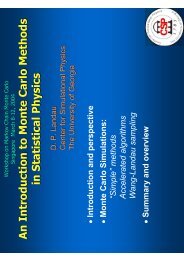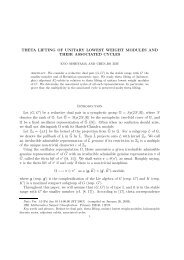Stein's method, Malliavin calculus and infinite-dimensional Gaussian
Stein's method, Malliavin calculus and infinite-dimensional Gaussian
Stein's method, Malliavin calculus and infinite-dimensional Gaussian
Create successful ePaper yourself
Turn your PDF publications into a flip-book with our unique Google optimized e-Paper software.
1. For every n, the application f 7! I n (f) is linear.<br />
2. For every n, one has E (I n (f)) = 0 <strong>and</strong> I n (f) = I n ( e f):<br />
3. For every n 2 <strong>and</strong> m 1, for every f 2 E ( n ) <strong>and</strong> g 2 E ( m ) (if m = 1, one can take<br />
g 2 L 2 ()),<br />
0<br />
if n 6= m<br />
E [I n (f) I m (g)] =<br />
n!hf; e egi L 2 ( n ) if n = m:<br />
(4.12)<br />
The proof of Proposition 4.2 follows almost immediately from the defnition (4.11); see e.g.<br />
[65, Section 1.1.2] for a complete discussion. By combining (4.12) with (4.8), one infers that I n<br />
can be extended to a linear continuous operator, from L 2 ( n ) into L 2 (P), verifying properties<br />
1, 2 <strong>and</strong> 3 in the statement of Proposition 4.2. Moreover, the second line on the RHS of (4.12)<br />
yields that the application<br />
I n : L 2 s ( n ) ! L 2 (P) : f 7! I n (f)<br />
(that is, the restriction of I n to L 2 s ( n )) is an isomorphism from L 2 s ( n ), endowed with the<br />
modi…ed scalar product n! h; i L 2 ( n ) , into L2 (P). For every n 2, the L 2 (P)-closed vector<br />
space<br />
C n (G) = I n (f) : f 2 L 2 ( n ) (4.13)<br />
is called the nth Wiener chaos associated with G. One conventionally sets<br />
C 0 (G) = R. (4.14)<br />
Note that (4.12) implies that C n (G) ? C m (G) for n 6= m, where “ ? ”indicates orthogonality<br />
in L 2 (P) :<br />
Remark (The case of Brownian motion). We consider the case where (Z; Z) = (R + ; B (R + ))<br />
<strong>and</strong> is equal to the Lebesgue measure. As already observed, one has that the process t 7! W t =<br />
G ([0; t]), t 0, is a st<strong>and</strong>ard Brownian motion started from zero. Also, for every f 2 L 2 (),<br />
Z<br />
Z 1<br />
I 1 (f) = f (t) G (dt) = f (t) dW t ; (4.15)<br />
R + 0<br />
where the RHS of (4.15) indicates a st<strong>and</strong>ard Itô integral with respect to W . Moreover, for<br />
every n 2 <strong>and</strong> every f 2 L 2 ( n )<br />
I n (f) = n!<br />
Z 1<br />
Z t1<br />
Z t2<br />
0<br />
0<br />
0<br />
Z tn 1<br />
<br />
0<br />
ef (t 1 ; :::; t n ) dW tn dW t2<br />
<br />
dW t1 ; (4.16)<br />
where the RHS of (4.16) st<strong>and</strong>s for a usual Itô-type stochastic integral, with respect to W , of<br />
the stochastic process<br />
Z t Z t2<br />
Z tn 1<br />
t 7! ' (t) = n! ef (t 1 ; :::; t n ) dW tn dW t2 , t 1 0.<br />
0 0 0<br />
15


